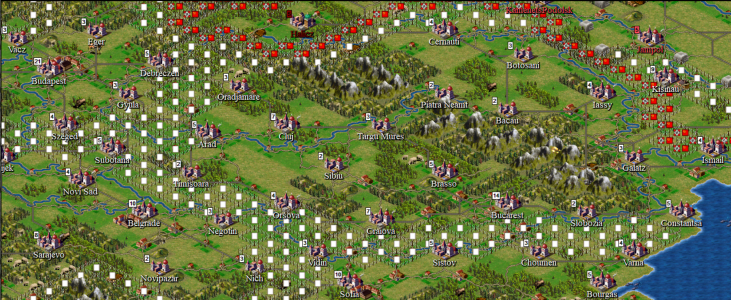Many thoughts are coming to life about this project currently paused while
finishing the TES second version and enthousiasmed by
The Spanish Civil War heavy update by Pablostuka coming soon :
+ Land War shall see an overhaul change, taking full advantage of its new ToTpp function, thus allowing for partial combats, retreats, strength and units personalisation.
+Naval War shall see a change too, with fleets, mine fields, and area of effect diverse reactions.
+Air War shall be roughly the same as planned.
+An introduction of "unit equipments" personilizing these, allowing to figure if an infantry (or armored) division has anti-tank equipments, more or less modern rifles, an artillery bataillon, anti-air canons, if a fleet has mine layers or mine sweepers, if bombers have low-middle-high altitude bomb tools or not, etc. Its is planned to have these upgrades linked with cities industries.
+Instead of getting ennemies' railroads out and his in (as first planned) each player turn, I'd rather have them spawned
-only in its territory
-only for few units : workers AND a train transporter unit going on railroads only. Railroad thus will become back an infinite movement factor, freeing movement abilities for planes !
+The "America Support" lone city is to be altered, scinded into tiny portions of canada and usa to interact with. Few ocean tiles shall picture the vastness of the Atlantic.
+Civilisations are to be altered, with the Italian and the Turc disapearing in favor to unplayable ones "Minor Axis" (at the beginning only consisting of slovakia) and "Minor Allied" (at the beginning consisting of Canadia and Poland). French shall remain first, its playability questionnable.
+Following influences from some of the best scenario avaibles, there shall be less diplomatic freedom than first intended, trying to follow more history and taking advantage for that of the added technologies thus proposing a lower tech paradigm to multiply tech interractions with the game.
+Pablostuka's idea of spying system shall be adapted there too. An important feature to bomber ennemies inlands !
+I'd like to alter the "natural healing" system provided by civ2, making it dependant of industries and manpower reserves.
Well, all this, maybe some more or less coming after the TES Stormcloak Rebellion v2.











